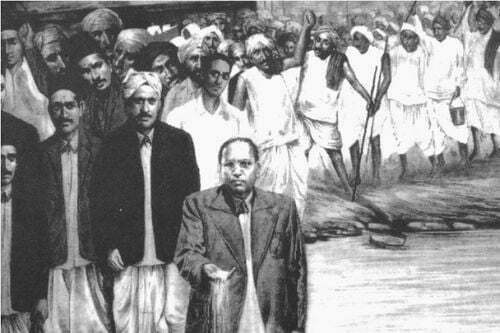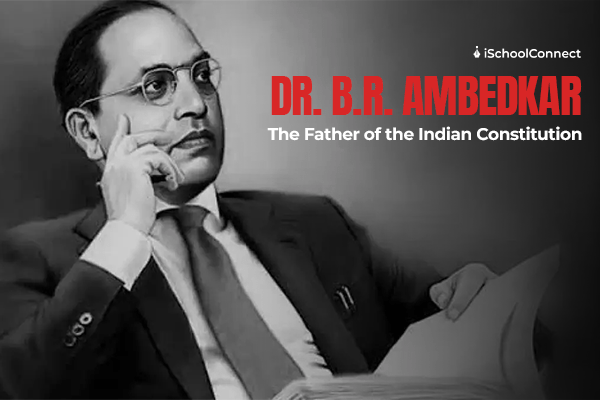Table of Contents
Along with multiple initiatives for the betterment of the nation, Dr. Ambedkar was the face of the Dalit movement in India. He is well-known as the principal architect of India’s Constitution.
Check out the blog to know more about the achievements and contributions of Dr. Babasaheb Ambedkar.
Facts about his early life
- Bhimrao was born into a Hindu Maharashtrian family of the ‘Mahaar’ caste on April 14, 1891, in Mhow, Madhya Pradesh. People from this caste were once known as ‘untouchables.’ He became a Buddhist in 1956.
- Despite their ability to attend school, Ambedkar and other children of this caste separated from their peers and received little attention or support from their teachers. They were not permitted to enter the classroom. If the untouchables wanted water, a higher caste member would have to pour it from a height because they were not allowed to touch the water or the vessel that contained it. This was normally done for Ambedkar by the school peon, and if the peon was unavailable, he had to go without water, a circumstance he subsequently characterized in his works as “No peon, No Water.” He had to sit on a gunny bag, which he was required to bring home with him at all times.
- Ambedkar was the world’s only person to stage a Satyagraha for clean drinking water.
- He was the first lawyer from a lower caste to practice law. His first name was Ambawedkar, but his teacher changed it to Ambedkar at school.
Education

- Babasaheb Ambedkar graduated from Elphinstone High School with honors in 1908.
- He then graduated from Bombay University with a master’s degree in Economics and Political Science in 1912. Ambedkar received a grant of twenty-five rupees per month from the Gaekwad monarch of Baroda, Sahyaji Rao III, in addition to passing all of his examinations. Ambedkar opted to use the money to further his education in the United States. He enrolled at Columbia University in New York City to study economics. After completing his thesis titled “Ancient Indian Commerce,” he received his Master’s degree in June 1915.
- In 1916, he began research on his dissertation thesis, “The Problem of the Rupee: Its Origin and Solution,” at the London School of Economics.
- Ambedkar became a professor of political economy at the Sydenham College of Commerce and Economics in Bombay with the support of former Bombay Governor Lord Sydenham.
- To enhance his knowledge, he traveled to England in 1920 at his own expense. The London University awarded him a D.Sc. there. Ambedkar also studied economics for a few months at the University of Bonn in Germany.
- In 1927, he got his Ph.D. in Economics. The University of Columbia conferred a doctorate on him on June 8, 1927.
- He studied for 21 years all around the world and earned master’s degrees in 64 topics. Apart from this, he was the first Indian to obtain a Ph.D. degree. He could speak nine languages.
Career
- Babasaheb Ambedkar went to institutions in the United States, the United Kingdom, and Germany to further pursue his education. After graduating from Bombay University with a bachelor’s degree in economics and political science, he went on to Columbia University in New York for his master’s degree before pursuing legal training in London.
- He was a key figure in drafting the Constitution after becoming the law minister. He was also instrumental in the formation of the Reserve Bank of India.
- In 1936, Ambedkar returned to India during the freedom struggle and published his magnum opus, ‘Annihilation of Caste,’ a blistering indictment of the caste system.
- Ambedkar is not only the first Indian to seek an Economics doctoral degree outside of India, but he is also the first South Asian to acquire both a Ph.D. and a double doctorate in Economics. He was also one of his generation’s most educated Indians.
- Ambedkar studied twenty-nine courses in economics, eleven in history, six in sociology, five in philosophy, four in anthropology, three in politics, and one each in rudimentary French and German during his three years at Columbia University.
Mahad satyagraha

- One of the pivotal occasions in Ambedkar’s political philosophy and activism was the Mahad Satyagraha of 1927. This satyagraha took place three years before Gandhi’s Dandi march, in the tiny Maharashtra village of Mahad. While Gandhi’s effort focused on salt, Ambedkar’s struggle focused on clean drinking water.
- Ambedkar not only asserted Dalits’ right to drink water from public water sources by bringing a group of Dalits to drink from Chavadar Lake in Mahad, but he also planted the seeds of Dalit liberation. In a well-known statement, he stated,
“We are not going to the Chavadar Tank to merely drink its water. We are going to the tank to assert that we, too, are human beings like others. It must be clear that this meeting has to set up the norm of equality.”
Achievements
- ‘Waiting for a Visa’ is a 20-page autobiographical narrative by Ambedkar in 1935-36 (after his return from America and Europe), and it is based on his early experiences with untouchability. The work is currently taught at Columbia University as a textbook.
- He was the first law minister of independent India but resigned after Parliament rejected his women’s rights bill.
- He raised the subject of working hours during the 7th session of the Indian Labour Conference in New Delhi on November 27, 1942. In India, he helped reduce working hours from 14 to 8 hours.
- Dr. Babasaheb Ambedkar has also contributed to the development of water resources. The Damodar Valley Project, Hirakud Project, and Sone River Valley Project were all developed and outlined by him.
- He framed many laws for women laborers. These laws include –
- Mines Maternity Benefit Act
- Women Labor Welfare Fund
- Women and Child, Labor Protection Act
- Maternity Benefit for Women Labor
- Restoration of Ban on Employment of Women on Underground Work in Coal Mines
Death
- Ambedkar had been suffering from major health issues, including diabetes and poor vision, between 1954 & 1955. He died on December 6, 1956, at his house in Delhi. Since Ambedkar converted to Buddhism, a Buddhist cremation was planned for him.
- Dr. Babasaheb Ambedkar was awarded the Bharat Ratna, India’s highest civilian honor after his death.
- Dr. B R Ambedkar was cremated at Chaitya Bhoomi which remains a memorial to him. Mahaparinirvan Din is commemorated on this day.
What we have to say
- Babasaheb Ambedkar was a great reformer who set the path for further progress, and his goal for a better India still lives on today.
- Dr. B.R. Ambedkar is India’s messiah for ‘Dalits’ and the oppressed.
- Despite his early difficulties and poverty, Ambedkar went on to become the most educated Indian of his time through his hard work and commitment.
- He is one of India’s finest leaders, who has consistently advocated for the rights of untouchables and other lower castes to be treated equally.
- He was a social activist who fought for social justice and equality.
Liked the blog? Comment below and share your thoughts with us!
Liked this blog? Read next: Self motivation | 8 steps to being a self-motivated person
FAQ’s
Q1. What is Dr. Babasaheb Ambedkar title?
Answer – Dr. Babasaheb Ambedkar is known as the father of the constitution.
Q2. Who defeated Dr. Ambedkar in the elections?
Answer – Narayan Sadoba Kajrolkar, an Indian independence activist, defeated Dr. Babasaheb Ambedkar in the elections.
Q3. Which university has Dr. Ambedkar’s statue in Japan?
Answer – The Koyasan University in Wakayama Prefecture, Japan, has Dr. Ambedkar’s statue.






